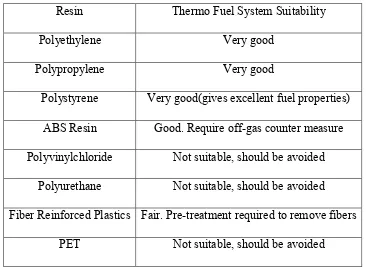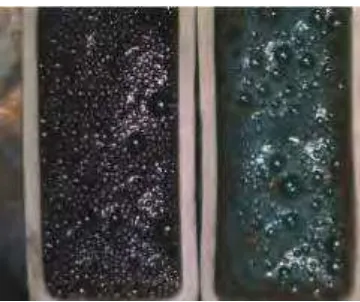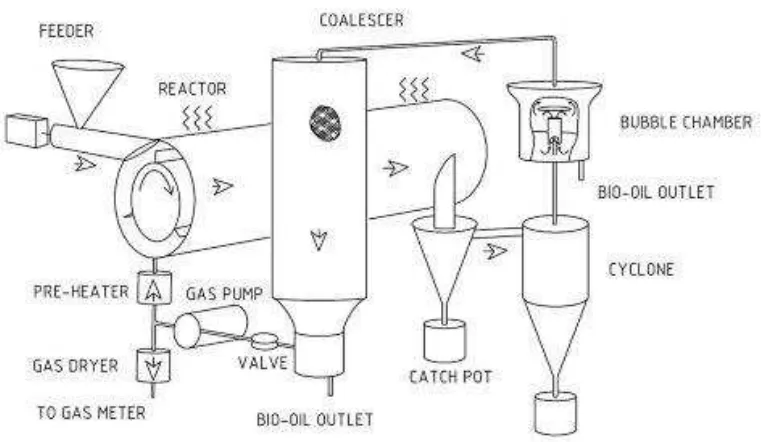SUPERVISOR DECLARATION
―I hereby declare that I have read this thesis and in my opinion this report is sufficient in terms of scope and quality for the award of the degree of
Bachelor of Mechanical Engineering (Plant and Maintenance)‖
Signature : ………
Name : DR HARYANTI SAMEKTO
DESIGN OF REACTOR FOR PLASTIC RECYCLING THROUGH PYROLYSIS PROCESS
MUHAMMAD SYAFIQ BIN M RADZALI
A thesis submitted in partial fulfillment of the requirement for the award of the degree of Bachelor of Mechanical Engineering (Plant & Maintenance)
Faculty of Mechanical Engineering Universiti Teknikal Malaysia Melaka
ii
DECLARATION
I declare that this thesis entitled “Design of Reactor for Plastic Recycling through Pyrolysis Process” is the result of my own research except summaries and
quotations which have been acknowledged.
Signature : ………
Name : MUHAMMAD SYAFIQ BIN M RADZALI
iii
iv
ACKNOWLEDGEMENT
v
ABSTRACT
vi
ABSTRAK
vii
TABLE OF CONTENTS
SUPERVISOR DECLARATION ... i
Declaration ... ii
Acknowledgement... iv
Abstract ... v
abstrak ... vi
Table of contents ... vii
List of Table ... x
List of Figure ... xi
Chapter I ... 12
Introduction ... 12
1.0 Background ... 12
1.1 Problem Statement ... 13
1.2 Objectives ... 13
1.3 Scope of Study ... 14
1.4 Report Organization ... 14
Chapter II ... 16
Literature Review ... 16
2.1 Introduction of polymer ... 16
viii
2.3 Design of reactor ... 19
2.4 Previous study ... 21
Chapter III ... 27
Methodology ... 27
3.1 Flowchart ... 27
3.2 Design 3d Modelling for reactor ... 29
3.3 Design optimization of reactor based on heat transfer ... 30
3.4 Fabrication of Optimized reactor ... 32
CHAPTER IV ... 34
design and finite element analysis... 34
4.1 Data collection ... 34
4.1.1 geometry of Furnace ... 34
4.1.2 The available reactor for biomass ... 36
4.2 3d Drawing Design ... 37
4.2.1 head Part drawing ... 37
4.2.2 body part drawing ... 38
4.2.3 Bottom part drawing ... 39
4.2.4 assembly drawing ... 40
4.3 heat transfer analysis ... 42
Chapter V ... 51
prototyping and functional evaluation ... 51
5.1 prototyping ... 51
5.2 performance evaluation ... 53
chapter vi ... 61
Conclusion ... 61
6.1 Conclusion ... 61
ix
x
LIST OF TABLE
xi
LIST OF FIGURE
12
CHAPTER I
INTRODUCTION
1.0 BACKGROUND
Nowadays, plastic recycling is the main issue of the world. The trashes that contributed by the human. The rubbish that been thrown widely from human daily life is the major factor of the polluted situation today. According to (Correy.R 2012), the world is consuming about 600 billion pounds of plastic annually and at the same time the market is still growing about 5% a year. The pyrolysis process is one of the recycle methods that reliable nowadays.
Recycle is the most effective way on reducing the consumption of plastic. Most of developing country in this world had jump and invest in recycle development. It will give much costing reduction and can also increase the economy of the country. Based on Eurostat 2010, the recycle development is driven by the increasing of recyclable demand as the Asian economies helps to increase the price of the material. Furthermore, another driver has been Europe waste directives, which have contributed by creating compulsory to recycle for recover the increment percentages of waste, and discouraging landfilling. As a consequence, the amount of recyclables sorted and placed on the market has increased 15 % between 2004 and 2009
13
According to (Passalaqua et al, 2013), pyrolysis is usually devoted to bio-oil production. As bio-oil is characterized by high energy density, the pyrolysis has received increasing interest in recent years compared to bulky biomass. Hence, the reactor of the pyrolysis can be the main focus of pyrolysis industry.
1.1 PROBLEM STATEMENT
The existing prototype reactor in UTeM Chemistry Laboratory is for biomass pyrolysis process. It is not suitable to use in plastic recycling through pyrolysis process as the reactor use different sample of material that to be burnt. The main purpose of existing reactor is for converting biomass into biodiesel fuel. The reactor that needs to be designed must suitable to burn plastic for recycles purpose.
Apart from that, the existing reactor was designed not following the mechanic specification and also not based on heat transfer condition. Hence the design need further study to ensure the mechanic and heat transfer of the reactor is suitable for plastic recycling through pyrolysis process.
1.2OBJECTIVES
1.2.1 To obtain information about process parameters for pyrolysis process. 1.2.2 To design a reactor and optimize the design based on finite element
analysis.
14
1.3 SCOPE OF STUDY
The scope of this report is all about plastic recycling reactor. The materials need to be used during the process are Polyethylene and Polypropylene. Polyethylene and Polypropylene are commonly used in human daily life. They also categorised as thermoplastic material.
Apart from that, this report focuses on design optimization of reactor that cover mechanic and heat transfer. The mechanic include of pressure, fatigue and factor of safety. The heat transfer part will include the method of heat transfer and the most suitable temperature that will be used during the pyrolysis process.
This report also focuses on fabrication of a pyrolysis prototype reactor that will be used in Chemistry Laboratory in UTeM. The prototype must also suitable to be adapted with available furnace in Chemistry Laboratory. This is to ensure that the plastic recycling through pyrolysis can be done effectively.
1.4REPORT ORGANIZATION
The first chapter of this report has discussed about the general of the project. The background of this report explains about the importance of conserve the environment by developing recycle project. Apart from that, this chapter also discussed about the problems to be covered in this project. This chapter also has defined the objectives to be carried out for the whole report. The scope of study also has been stated clearly for enlighten the focus of this report.
15
The third chapter of this report is mainly about the methodology of the project. The t progress is according to the flow chart that has been provided for the entire of the project. This chapter discuss on methods that being used in this project to achieve the expected result of the reactor design. The project will follow the procedure on analysis of heat transfer and mechanics. This chapter also state the method being used to fabricate the scale down prototype reactor.
The forth chapter of this report is mainly about the development of the pyrolysis reactor design. The general geometry of the design was being explained in this chapter. Apart from that, this chapter will show the result of thermal stress analysis of the design. The result also is discussed in this chapter.
The fifth chapter of this report has discussed about the prototyping of designed pyrolysis reactor. The fabrication of each part of the pyrolysis prototype reactor was discussed generally according to the design that has been discussed early in fourth chapter. This chapter also show the performance evaluation of the pyrolysis prototype reactor.
16
CHAPTER II
LITERATURE REVIEW
2.1 INTRODUCTION OF POLYMER
Polymer is consisting of a long chain of repeating chemical units called monomers. The bonding between the one monomer to another may be in linear, cycled and also branches. When the polymer undergoes polymerization, it is called a homopolymer. The examples of homopolymer are polyethylene, polypropylene and polystyrene. The polymer also divided into three types which are thermoset, thermoplastic and elastomer (Shakhashiri, 2012)
Thermoplastic polymer can be recycled and can be used again by break the chain of polymerization. The molecular chain of the thermoplastic material is not cross-linked to each other. Hence, with the application of a sufficient amount of heat, the thermoplastic can be moulded, shaped and extruded.
Polyethylene is characterized as a semi-crystalline polymer, made up of crystalline regions and amorphous regions. Crystalline regions are those of highly ordered, neatly folded, layered (in parallel) and densely packed molecular chains. These occur only when chains branching off the sides of the primary chains are small in number.
17
An abundance of closely packed polymer chains results in a tough material of moderate stiffness.
The melting point of polyethylene is defined as that temperature at which the plastic transitions to a completely amorphous state. Polyethylene is one of thermoplastic polymer.
Polypropylene is a polymer produced by the addition polymerization of propylene, CH =CHCH (propene). Its 2 3molecular structure is similar to that of polyethylene, but has a methyl group (–CH ) on alternate carbon three atoms of the chain. Its molar masses fall in the range 50 000 to 200 000 grams. Polypropylene is slightly more brittle than polyethylene, but softens at a temperature about 40 oC higher. This polymer is used extensively in the automotive industry for interior, instrument panels and in food packaging. (Shakhashiri, 2012).
Table 2.1: Material used in Pyrolysis
Resin Thermo Fuel System Suitability
Polyethylene Very good
Polypropylene Very good
Polystyrene Very good(gives excellent fuel properties) ABS Resin Good. Require off-gas counter measure Polyvinylchloride Not suitable, should be avoided
Polyurethane Not suitable, should be avoided Fiber Reinforced Plastics Fair. Pre-treatment required to remove fibers
18
Figure 2.1: Polypropylene (left) Polyethylene (right) (Yin.L.J, 2014)
2.2 PYROLYSIS PROCESS
Thermofuel is a truly sustainable waste solution, diverting plastic waste from landfills, utilizing the embodied energy content of plastics and producing a highly usable commodity that, due to its cleaner burning characteristics, is in itself more environmentally friendly than conventional distillate.
According to Thoray P.V. et al, 2013 int their journal, pyrolysis is a process of thermal degradation in the absence of oxygen. According to numerous experiments of waste plastics pyrolysis, it has been found that their volatile evaporation stage is similar to water evaporating from molten polymer evaporation that characterized with formation of bubble evaporation on a well-heated surface.
19
Plastic waste is continuously treated in a cylindrical chamber and the pyrolytic gases condensed in a specially designed condenser system to yield a hydrocarbon distillate comprising straight and branched chain aliphatics, cyclic aliphatics and aromatic hydrocarbons. The resulting mixture is essentially equivalent to petroleum distillate. The plastic is pyrolised at 370ºC- 450ºC and the pyrolysis gases are condensed through a distillation tower to produce the distillate.
According to Grammelis. P, 2007, for biomass pyrolysis, the temperatures needed to run the process is about 400oC to 800oC. Gas, liquid and solid char are produced, the relative proportions of which depend mainly on the reaction parameters of temperature and reaction time as well as of the rate of heat transfer to biomass feedstock.
Figure 2.2: Fast Pyrolysis Process (Bech.N, 2009)
2.3 DESIGN OF REACTOR
20
determinations on deposition onto reactor linings and in the gas filters. Recirculation of tar vapors around the mesh could not be avoided. Initially, the high-pressure wire-mesh reactor designs were to examine the possibilities of hydropyrolysis as a process route for making liquids and substitute natural gas.
Hydropyrolysis was one of the research strands pursued in Europe and North America in the decade following the war of 1973 in the Middle East and the subsequent oil price increases. Pure high-pressure hydrogen was to be reacted with coal, to produce primarily methane and a tar. The suitability of the tars as a source of synthetic fuels and chemicals was to be explored. With the benefit of hindsight, it is not clear how this scheme was ever conceived as a process route with economic potential. In the first decade of the new millennium, we find ourselves in a quest for the ―hydrogen economy‖, wishing for large amounts of pure hydrogen shorn of its ―undesirable‖ companion, the carbon atom.
Nevertheless, in the mid-1980s, hydropyrolysis was investigated by British Gas and a consortium including several Japanese companies, led by Osaka Gas. At the time, the Japanese gas industry was looking into technically viable alternatives to the massive 2 imports of LNG, which they later committed themselves to. A 2-ton per day pilot entrained flow reactor at Solihull (UK) was followed by a 50-ton per day facility in Osaka.
The Japanese government having initially pledged about $125 million for this development, eventually abandoned the project early in the new century. In the summer of 2001, Syngenta was still putting out feelers for relaunching bench scale hydropyrolysis research. This occurred when natural gas prices had temporarily spiked to around $10 per million BTU. At the end of the summer, however, gas fell back to about a third of that price and interest waned. Notwithstanding these economic ups and downs, hydropyrolysis was one of the technically most successful applications of the wire-mesh reactor configuration.
21
temperatures, containment vessels operating at pressures required by gasification tests do not require exceptional alloys or very specialized designs.
On the other hand, such assemblies usually turn out to be bulky. These larger rigs usually require several operators alongside relatively complex instrumentation. The high construction costs and accompanying expenses would, at least in part, explain the relatively small number of such units in existence.
2.4PREVIOUS STUDY
Bech et al in their study discussed about the flash pyrolysis process of straw and wood by using pyrolysis centrifugal reactor. The paper discuss about the modelling solid convective flash pyrolysis. The model describes the presented experimental results adequately for engineering purposes for both wood and straw feedstock even though conditions for ablative pyrolysis from a reaction engineering point of view are not satisfied. Accordingly, even though the concept of an ablative melting particle may constitute a limiting case, it can still be used to model flash pyrolysis provided that the reacting particle continuously shed the formed char layer.
22
23
with char, it is uncertain whether this is the result of poor collection of organics for this data point. In any case the model appears to be satisfactory for engineering purposes. Due to the lack of published kinetic data for wheat straw, it was attempted to employ the superposition kinetic scheme. By dividing each size fraction into its three main organic components cellulose, hemicellulose, and lignin and modelling each separately using kinetic data for the pure components the result was obtained by averaging over composition and then particle size. However, not unexpectedly this approach proved unsuccessful properly because the influence of ash components is of more importance than the organic composition for the yield of products. Interestingly, for pines the simple cellulose kinetics more accurately described the experimental results than the detailed superposition model. Accordingly, it was decided to use the cellulose kinetic data which had been given wood results with wood but modify them to obtain an acceptable fit. It has been reported that the alkali metal content in herbaceous biomass has a pronounced catalytic effect on the pyrolytic reactions favouring the formation of char and gas the activation energies by 14% and 4.5%, respectively, produced an acceptable fit but could likely be improved by investigating the kinetics for straw in more detail.



